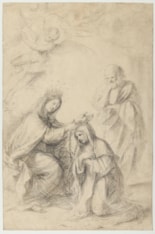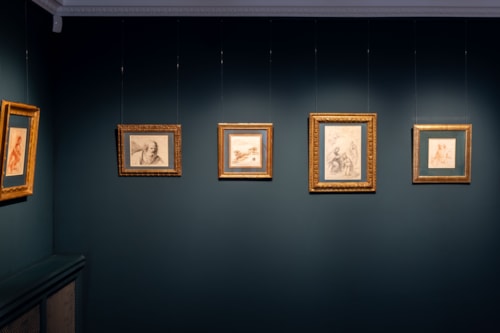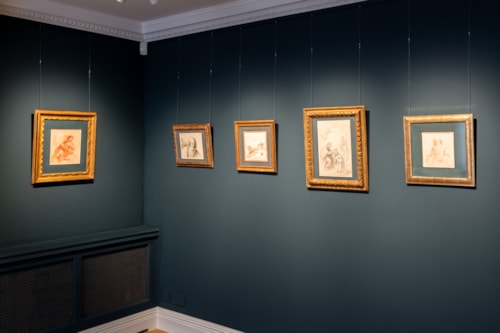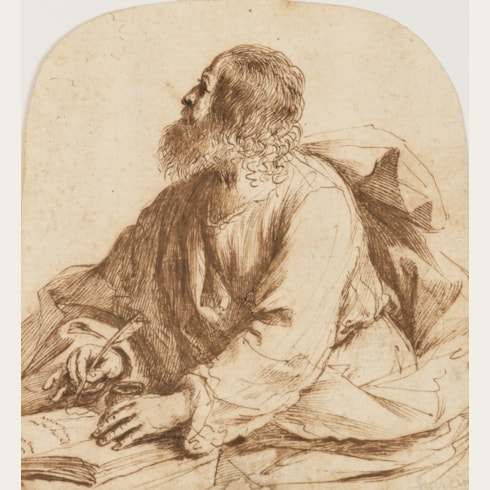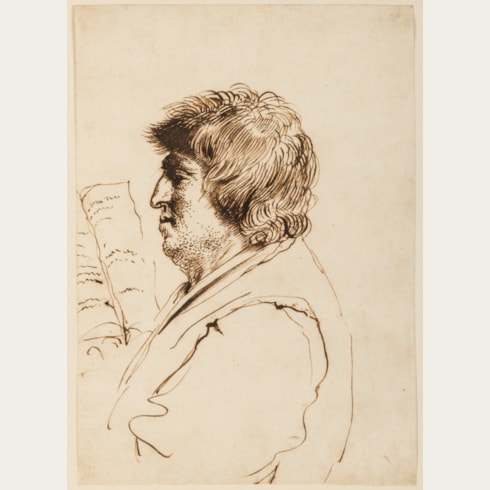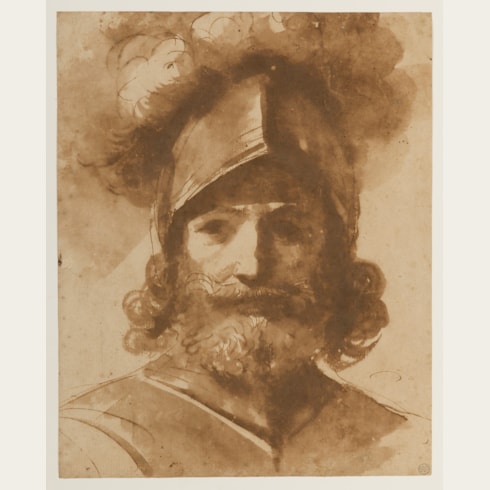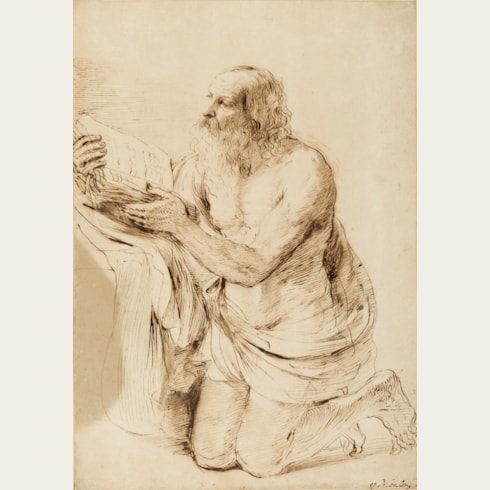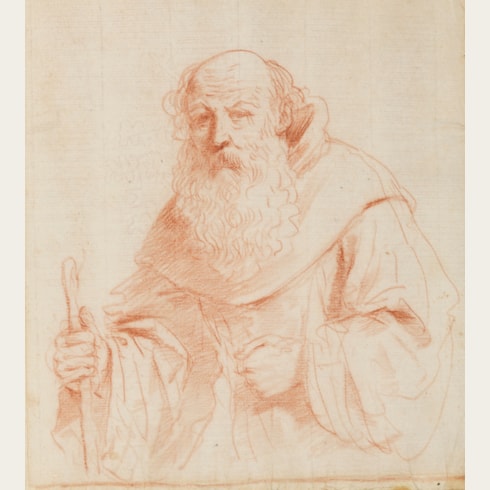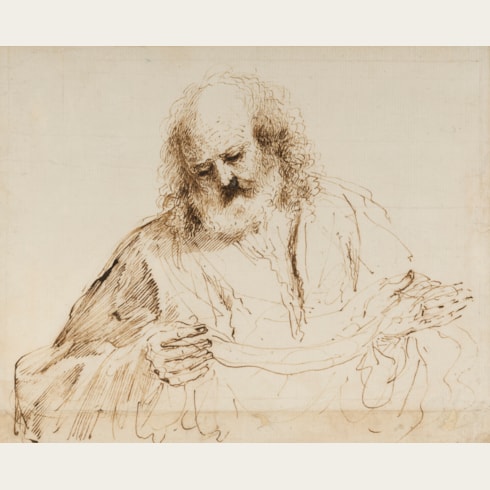Giovanni Francesco Barbieri GUERCINO
(Cento 1591 - Bologna 1666)
Saint Teresa Receiving a Necklace from the Virgin, with Saint Joseph Behind
Laid down.
Faintly inscribed Guercino in black chalk at the lower left.
361 x 238 mm. (14 1/4 x 9 3/8 in.)
This fine compositional drawing in matita nera is a study for Guercino’s late altarpiece of The Vision of Saint Teresa of Ávila (or Saint Teresa Receiving a Necklace from the Virgin in the Presence of Saint Joseph), painted for the convent church of San Gabriele delle Monache Carmelitane Scalze in Bologna. Guercino began working on the painting in 1660 and received payment of 800 Bolognese lire for the altarpiece on 21 March 1661. The painting remained in the church of San Gabriele until 1811, when it was transferred to the Pinacoteca di Brera in Milan. Exhibited there between 1811 and 1965, the painting has since been returned on loan to the Carmelite convent in Bologna.
The scholar and curator Jacob Bean once noted that ‘When Guercino took pen in hand and jotted down alternative solutions to a compositional problem, he was almost invariably bursting with ideas. Often a series of preparatory drawings for a picture proposes figure groupings so radically different that only certain fixed iconographical features of the subject and a stylistic unity identify the drawings as preparatory for the same picture.’
Two further compositional studies for the 1661 altarpiece of The Vision of Saint Teresa of Ávila, both with significant differences to the final painting, were formerly in the collection of Sir Denis Mahon and are now in the Ashmolean Museum in Oxford; one is a rapid study in pen and wash and the other a more highly finished drawing in two shades of red chalk. A third compositional drawing, executed in pen and wash, appeared at auction in London in 1983 and is now in a private collection. This last drawing is somewhat closer to the present sheet than the two Ashmolean sheets, particularly in the poses of both the Virgin and Saint Theresa, as well as the prominent angel just above them.
Finally, two drapery studies in red chalk for the altarpiece are part of the large group of such drawings by Guercino today in the Koenig-Fachsenfeld collection at the Staatsgalerie in Stuttgart. These are a highly finished drawing for the mantle of the seated Virgin and a double-sided sheet which contains studies for the drapery of both the Virgin and Saint Joseph.
Giovanni Francesco Barbieri, known as Il Guercino (‘the squinter’) because he was cross-eyed, was by the second decade of the 17th century one of the leading painters in the province of Emilia. Born in Cento, a small town between Bologna and Ferrara, Guercino was largely self-taught, although his early work was strongly influenced by the paintings of Ludovico Carracci. In 1617 he was summoned to Bologna by Alessandro Ludovisi, the Cardinal Archbishop of Bologna, and there painted a number of important altarpieces, typified by the Saint William Receiving the Monastic Habit, painted in 1620 and now in the Pinacoteca Nazionale in Bologna. When Ludovisi was elected Pope Gregory XV in 1621, Guercino was summoned to Rome to work for the pontiff and his nephew, Cardinal Ludovico Ludovisi. It was in Rome that Guercino painted some of his most celebrated works, notably the ceiling fresco of Aurora in the Casino Ludovisi and the large altarpiece of The Burial and Reception into Heaven of Saint Petronilla for an altar in Saint Peter’s. The papacy of Gregory XV was short-lived, however, and on the death of the Pope in 1623 Guercino returned to his native Cento. He remained working in Cento for twenty years, though he continued to receive commissions from patrons throughout Italy and beyond, and turned down offers of employment at the royal courts in London and Paris. Following the death of Guido Reni in 1642, Guercino moved his studio to Bologna, where he received commissions for religious pictures of the sort that Reni had specialized in, and soon inherited his position as the leading painter in the city.
Guercino was among the most prolific draughtsmen of the 17th century in Italy, and his preferred medium was pen and brown ink, although he also worked in red chalk, black chalk, and charcoal. He appears to have assiduously kept his drawings throughout his long career, and to have only parted with a few of them. Indeed, more drawings by him survive today than by any other Italian artist of the period. On his death in 1666 all of the numerous surviving sheets in his studio passed to his nephews and heirs, the painters Benedetto and Cesare Gennari, known as the ‘Casa Gennari’.
The drawings of Guercino, which include figural and compositional studies, landscapes, caricatures and genre scenes, have always been coveted by later collectors and connoisseurs. Indeed, the 18th century amateur Pierre-Jean Mariette noted of the artist that ‘Ce peintre a outre cela une plume tout-à-faite séduisante’. The largest extant group of drawings by Guercino is today in the Royal Collection at Windsor Castle; these were acquired from the Gennari family by King George III’s librarian, Richard Dalton, between about 1758 and 1764.
Provenance
Gérard Lhéritier (Aristophil), Nice.
Literature


